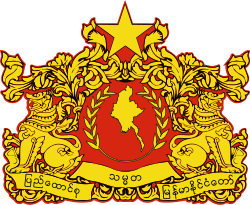Burmese general election, 1947
| | |||||||||||||||||||||||||||||||||||||||
| |||||||||||||||||||||||||||||||||||||||
| |||||||||||||||||||||||||||||||||||||||
| |||||||||||||||||||||||||||||||||||||||
 |
| This article is part of a series on the politics and government of Myanmar |
|
|
|
General elections were held in Burma on 9 April 1947 to form the basis of a constituent assembly that would design a constitution once independence from the United Kingdom had been achieved.[1] They were the first elections in Burma since its separation from India under the British Raj.[2] Voter turnout was 49.8%.[3] However, Aung San was assassinated three months later, resulting in U Nu becoming the first Prime Minister of Burma.
Background
The elections were among a number of provisions agreed on 27 January 1947 between Burmese nationalist Aung San on a visit to London and British Prime Minister Clement Attlee guaranteeing Burma's independence from the UK within a year.[4]
Campaign
In 56 non-communal constituencies, candidates from the Anti-Fascist People's Freedom League (AFPFL) ran unopposed. U Saw, leader of the Patriot's Party, accused the AFPFL of intimidation and corruption during the election campaign and boycotted the election, as did Ba Sein and his party, accusing the AFPFL of being a "stooges" of British imperialism.[5][6] Reasons given for the low turnout included the instability left by the Japanese occupation of Burma and the struggle for independence.[1] Other candidates in the election included a few independents and communists.[7] The election was certified as free and fair.[2]
Results
Turnout was generally low, around 50% in contested constituencies.[1]
| Party | Votes | % | Seats |
|---|---|---|---|
| Anti-Fascist People's Freedom League | 1,755,000 | 173 | |
| Communist Party of Burma | 126,000 | 7 | |
| Karen Youth Organisation | 109,000 | 19 | |
| Independent Karen | 5 | ||
| Anglo-Burmese | 4 | ||
| Independents | 2 | ||
| Invalid/blank votes | – | – | |
| Total | 100 | 210 | |
| Registered voters/turnout | 49.8 | – | |
| Source: Nohlen et al. | |||
Aftermath
On 19 July 1947, Aung San was assassinated along with six other members of the party and the leadership of the AFPFL was taken over by U Nu.[8] A constitution was approved on 24 September 1947 and independence granted on 4 January 1948.[2]
See also
References
- 1 2 3 Rotberg, Robert I. (1998). Burma: prospects for a democratic future (2nd ed.). Brookings Institution Press. p. 42. ISBN 978-0-8157-7582-9.
- 1 2 3 Saffin, Janelle (2000). "Burma's Election and Constitutional History: A Snapshot". Legal Issues on Burma Journal. Burma Lawyers' Council. 7.
- ↑ Dieter Nohlen, Florian Grotz & Christof Hartmann (2001) Elections in Asia: A data handbook, Volume I, p610 ISBN 0-19-924958-X
- ↑ Oṅ, Chan; Silverstein, Josef (1993). The political legacy of Aung San. SEAP Publications. p. 4. ISBN 978-0-87727-128-4.
- ↑ A.A.P. (April 9, 1947). "Burmese go to the polls, boycotts by most parties". The Sydney Morning Herald.
- ↑ Appleton, G. (1947). "Burma Two Years After Liberation". International Affairs. Blackwell Publishing. 23 (4): 510–521. JSTOR 3016561.
- ↑ Hendershot, Clarence (1947). "Burma Compromise". Far Eastern Survey. Institute of Pacific Relations. 16 (12): 133–138. doi:10.1525/as.1947.16.12.01p0193t.
- ↑ Morse, Erik A.; Mitchell, Ronald K. (2006). Cases in entrepreneurship: the venture creation process. SAGE. p. 61. ISBN 978-1-4129-0976-1.


